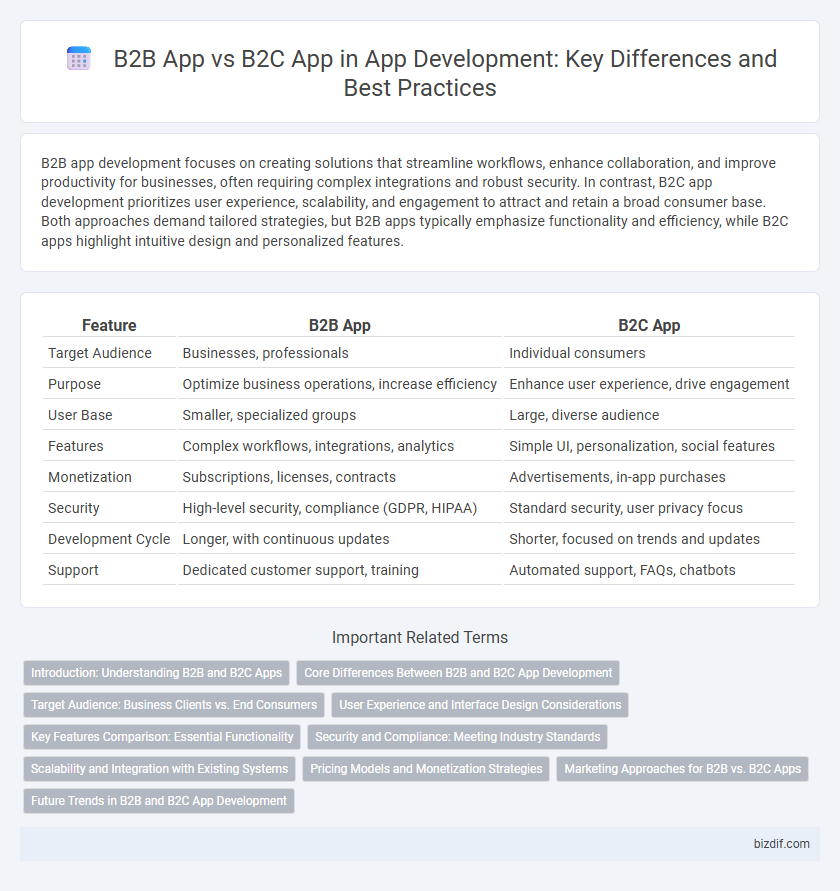B2B app development focuses on creating solutions that streamline workflows, enhance collaboration, and improve productivity for businesses, often requiring complex integrations and robust security. In contrast, B2C app development prioritizes user experience, scalability, and engagement to attract and retain a broad consumer base. Both approaches demand tailored strategies, but B2B apps typically emphasize functionality and efficiency, while B2C apps highlight intuitive design and personalized features.
Table of Comparison
| Feature | B2B App | B2C App |
|---|---|---|
| Target Audience | Businesses, professionals | Individual consumers |
| Purpose | Optimize business operations, increase efficiency | Enhance user experience, drive engagement |
| User Base | Smaller, specialized groups | Large, diverse audience |
| Features | Complex workflows, integrations, analytics | Simple UI, personalization, social features |
| Monetization | Subscriptions, licenses, contracts | Advertisements, in-app purchases |
| Security | High-level security, compliance (GDPR, HIPAA) | Standard security, user privacy focus |
| Development Cycle | Longer, with continuous updates | Shorter, focused on trends and updates |
| Support | Dedicated customer support, training | Automated support, FAQs, chatbots |
Introduction: Understanding B2B and B2C Apps
B2B apps cater to business users, streamlining operations, enhancing collaboration, and improving workflow efficiency through specialized tools and integrations. B2C apps target individual consumers, emphasizing user experience, personalization, and engagement to drive customer satisfaction and retention. Understanding the distinct requirements and user behaviors in B2B versus B2C apps is crucial for optimizing functionality and market fit.
Core Differences Between B2B and B2C App Development
B2B app development focuses on complex workflows, integration with existing enterprise systems, and scalability to handle multiple users with varying access levels, whereas B2C apps prioritize user-friendly interfaces and high performance to support large-scale, direct customer interactions. B2B applications often emphasize security, compliance, and tailored functionalities specific to business processes, while B2C apps require engaging features, personalization, and seamless payment integration to enhance customer experience. The development cycles for B2B apps typically involve longer timelines with extensive testing phases compared to the faster, iterative updates seen in B2C app development.
Target Audience: Business Clients vs. End Consumers
B2B apps target business clients, emphasizing features like workflow automation, integration with enterprise systems, and scalability to support organizational needs. In contrast, B2C apps focus on end consumers, prioritizing user experience, intuitive interfaces, and personalized content to drive engagement and retention. Understanding the distinct demands of target audiences guides developers in creating tailored solutions that align with business goals or consumer preferences.
User Experience and Interface Design Considerations
B2B app development prioritizes streamlined workflows and data-driven interfaces tailored to professional users requiring efficiency and precision, whereas B2C apps emphasize intuitive navigation, engaging visuals, and personalized experiences to attract and retain diverse consumer groups. User experience design in B2B apps often involves complex dashboards, integration with enterprise software, and robust security features, while B2C interfaces focus on simplicity, emotional engagement, and fast interaction times. Understanding these distinctions ensures the development of apps that meet the specific needs of target audiences, enhancing usability and satisfaction across both business and consumer contexts.
Key Features Comparison: Essential Functionality
B2B apps emphasize scalability, robust security, and advanced analytics to support complex workflows and multi-user environments, enabling seamless collaboration and data-driven decision-making for enterprises. B2C apps prioritize user-friendly interfaces, personalized experiences, and streamlined navigation to enhance customer engagement and retention across diverse devices. Both app types integrate APIs and real-time notifications, but B2B apps often feature role-based access controls and extensive customization options, while B2C apps focus on intuitive design and social media integration.
Security and Compliance: Meeting Industry Standards
B2B apps emphasize stringent security protocols and compliance with industry regulations such as GDPR, HIPAA, and SOC 2 to protect sensitive enterprise data and maintain trust among corporate clients. B2C apps focus on securing user data through encryption, two-factor authentication, and compliance with data privacy laws like CCPA, ensuring customer information remains private and secure. Both B2B and B2C app development require ongoing security updates and audits to address emerging threats and adhere to evolving compliance standards.
Scalability and Integration with Existing Systems
B2B apps prioritize scalability to support complex workflows and high user volumes typical in enterprise environments, often requiring seamless integration with existing ERP, CRM, and other legacy systems through APIs and middleware. In contrast, B2C apps focus on handling large, diverse user bases efficiently, emphasizing scalability for peak traffic and integrating primarily with social media, payment gateways, and marketing platforms. Effective integration in B2B apps ensures data consistency and process automation across organizational tools, while B2C apps leverage integration for enhanced user experience and personalized services.
Pricing Models and Monetization Strategies
B2B app pricing models often rely on subscription-based plans or tiered pricing to accommodate varying business sizes and feature needs, maximizing consistent revenue streams. B2C apps typically use freemium models, in-app purchases, or ad-based monetization to attract a broad user base and encourage microtransactions. Understanding the distinct purchasing behaviors and long-term value metrics of businesses versus individual consumers is crucial for optimizing monetization strategies in app development.
Marketing Approaches for B2B vs. B2C Apps
B2B app marketing emphasizes relationship-building, targeted content, and demonstrating ROI to engage decision-makers within organizations. B2C app marketing focuses on broad audience reach, emotional appeal, and user experience to drive downloads and brand loyalty. Data analytics and personalized messaging are critical for optimizing campaigns in both B2B and B2C app development strategies.
Future Trends in B2B and B2C App Development
Future trends in B2B app development emphasize AI-driven automation, enhanced data security measures, and seamless API integrations to streamline business processes and improve decision-making. B2C app development is shifting toward hyper-personalization, immersive AR/VR experiences, and AI-powered customer insights to boost engagement and user retention. Both sectors are increasingly adopting edge computing and 5G technology to enhance app performance and real-time responsiveness.
B2B app vs B2C app Infographic

 bizdif.com
bizdif.com